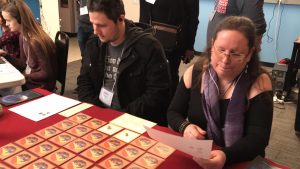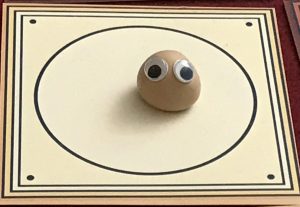ETC festival gave us the chance to present our work to a large group of audience.
The games were played by multiple people, both guests and people from the industry.
For our finals we presented the process we went through this semester the lessons that we learned.
Some of the things that went well this semester were the research of definition of transformational goals and the communication with teens.
One thing that went well this semester was the research. The designers used several sources for their research, online and offline. One of the major sources were the Transformational Framework by Sabrina Culyba. That helped us define the goals and barriers for reaching them. The goals were only a part of the concept and not the complete concept itself. For example – for empathy, we weren’t trying to teach empathy in general but specifically Active Listening.
When we chose a goal that already was thought in some way (for example, for Active Listening there are multiple online guides) that helped us build the narrative and game mechanics. It is highly recommended for future transformational games to not try and tackle the entire concept or concepts that are bigger than the scope of the semester.
The second thing that went well was our relationship with teenagers. Thanks to John Balash we were able to form a relationship with a local school which enabled us to do multiple testing sessions. Due to the progress of the project and the scope we were unable to test if the games are effective and mostly used our testing to improve the game mechanics.
Our main setback was due to miscommunication with our client. It wasn’t clear for them and for us what it is exactly what they want. Our original plan was making six mini-games and to base the mechanics and game on principles of the positive psychological constructs and based on our conversations with teenagers.
However, our first prototypes where not what our client was expecting. They wanted us to define the transformational goals and address them and not only use the construct in the mechanics. The next step after that was conducting research, defining barriers and goals. We lost around half a semester before we reached a stage where we were ready to start working on our final games.
The second thing that could have been handled better was the schedule and “resource” management. We started by having all three programmers working on one game. However, by the end, it seemed that that was necessary and only prevented from designers on working on their games. The end result was that the last game in the schedule got less attention and at the end, it’s design needed more work.
iThrive are planning on putting a version of the games (either a file to download or a print and play version of the tabletop game) on their website. They are also planning on changing their design guides based on the things that we have learned through the semester. For Curiosity, for example, they have learned that it is hard to make a game that emphasizes the learning goals since players already work in a “curious” way when playing games (exploring, etc..).
It’s impossible to tackle everything that constructs the psychological constructs in one mini-game. Therefore, each game focuses on a part of the construct. For example, the Empathy game is only about active listening.
In order to have strong learning moments, it is good to have reflection moments in the game. For example, feedback and explanation on why some choices are “right” or “wrong” or creating a discussion by having two players play the game or by having a moderator.

